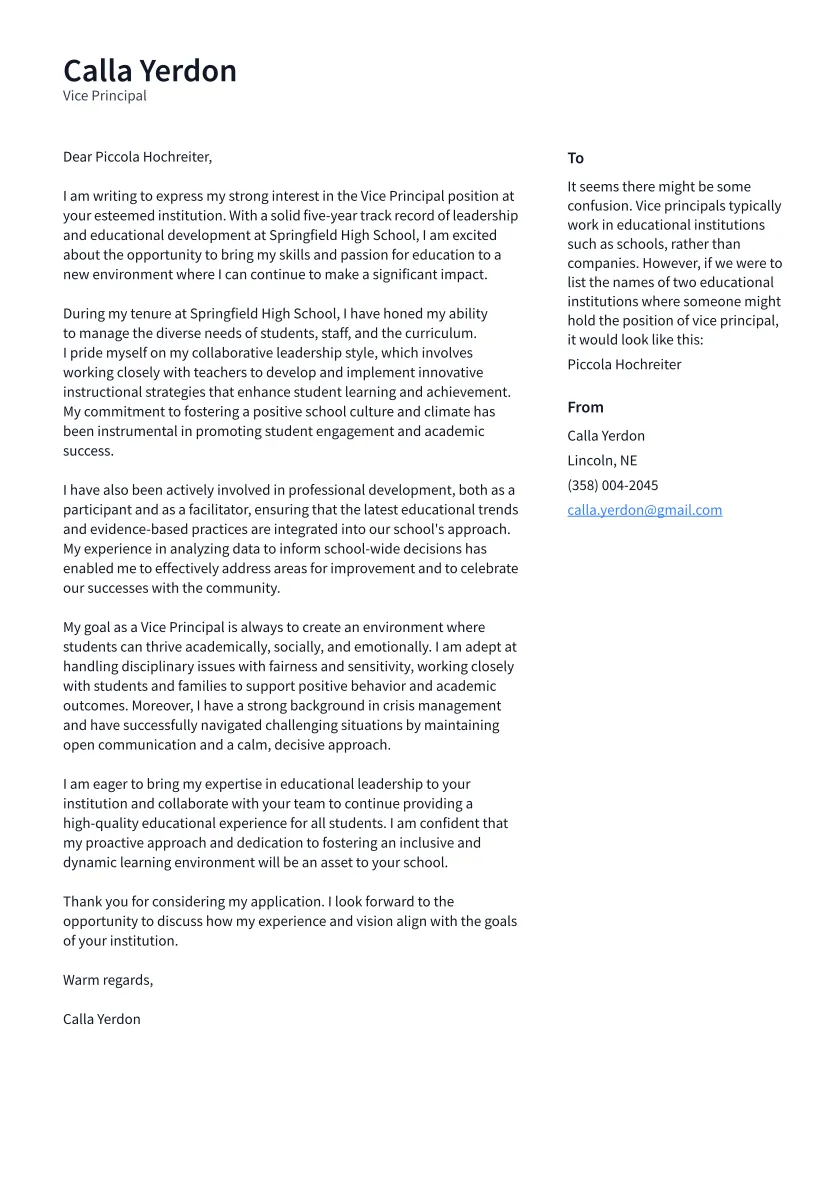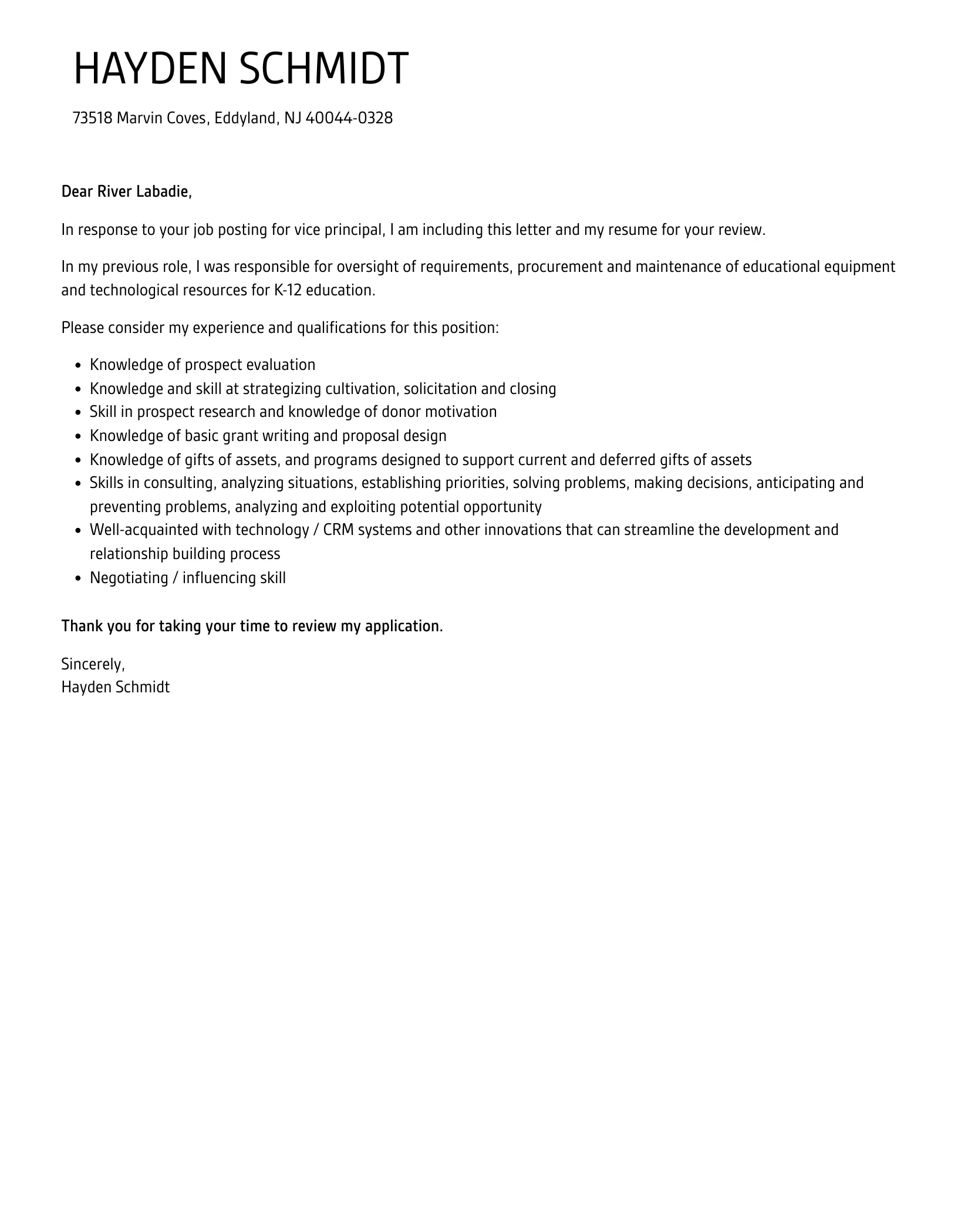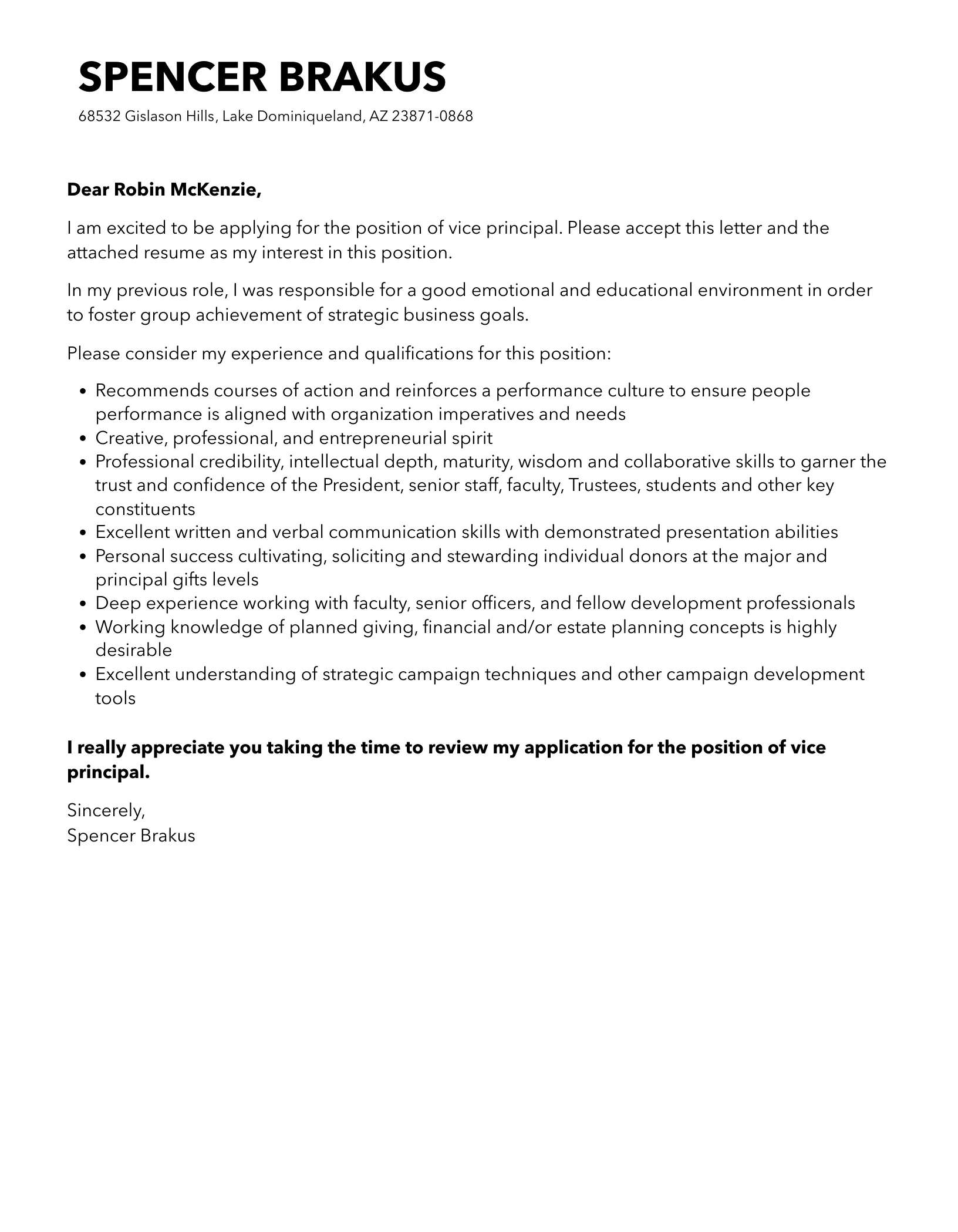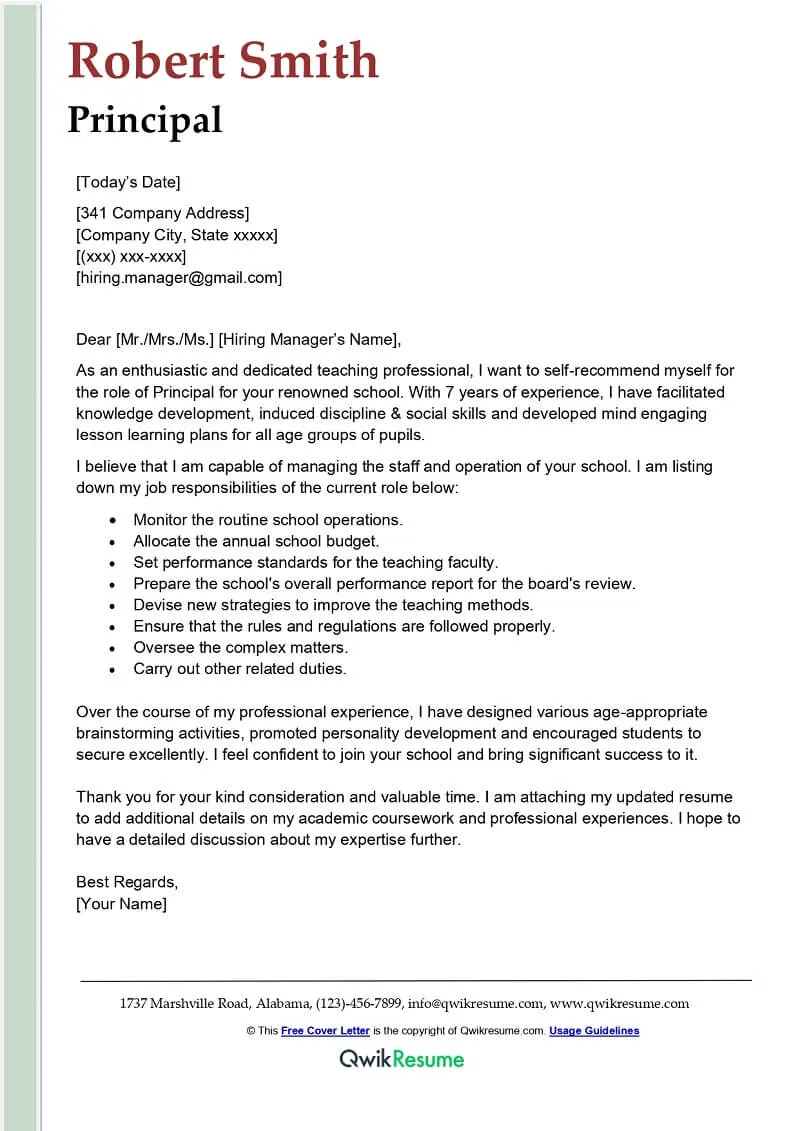Crafting a Compelling Cover Letter
A well-crafted cover letter is your first opportunity to make a lasting impression on a hiring committee. For a Vice Principal position, it’s not just about listing your qualifications; it’s about showcasing your leadership potential, educational philosophy, and understanding of the school’s specific needs. This guide will walk you through each step of creating a cover letter that grabs attention, highlights your strengths, and sets you apart from other candidates. Remember, the goal is to demonstrate why you are the perfect fit for this crucial role, turning a simple application into a compelling narrative of your capabilities and aspirations. A strong cover letter shows that you have put in the effort and are genuinely interested in the position. This attention to detail speaks volumes about your dedication and professionalism, making you a more attractive candidate. So, let’s begin crafting a cover letter that opens doors to opportunity.
Understanding the Role of a Vice Principal
Before you even start writing, understand the multifaceted responsibilities of a Vice Principal. This role often involves supporting the Principal in school administration, overseeing student discipline, managing staff, and fostering a positive school climate. A Vice Principal is a leader, mentor, and problem-solver. They also act as a crucial link between teachers, students, parents, and the Principal, ensuring smooth operations and a collaborative environment. A deep understanding of these responsibilities will inform your cover letter, enabling you to tailor your experience and skills to meet the school’s specific needs. Research the specific job requirements. This will ensure you highlight the skills that are most important to the school.
Key Responsibilities and Skills

Identify the key responsibilities and skills that Vice Principals commonly utilize. This typically includes classroom management expertise, student support and disciplinary procedures, and staff evaluation. Leadership abilities, such as strategic planning and decision-making, are also essential. Excellent communication skills, the ability to resolve conflicts, and a commitment to fostering a positive school culture are critical. When writing your cover letter, showcase your abilities in these areas. Use specific examples to illustrate how you have successfully managed these responsibilities in previous roles. This will paint a clear picture of your capabilities and demonstrate your readiness to excel in the position of Vice Principal. Highlight areas where you have exceeded expectations or implemented successful initiatives. This demonstrates proactive leadership and innovation.
Researching the School and Its Needs
Before you start writing your cover letter, it’s crucial to research the school and its needs. Visit the school’s website, read any available strategic plans, and review the school’s mission and values. Understand the school’s demographics, academic performance, and any ongoing initiatives. Identify the challenges and opportunities the school faces. Tailor your cover letter to address these specifics, showing that you understand the school’s context and have the skills to contribute to its success. For example, if the school is focused on improving student achievement in STEM subjects, highlight your relevant experience in this area. This will signal to the hiring committee that you are not just applying for a job, but are genuinely interested in supporting the school’s mission. Researching the school will allow you to create a cover letter that is tailored to their needs, rather than a generic template.
Highlighting Relevant Experiences
Your cover letter should highlight your most relevant experiences. Focus on positions where you have demonstrated leadership, administrative, and educational expertise. Provide specific examples of your accomplishments. Quantify your achievements whenever possible. This could include a percentage increase in student test scores, a decrease in disciplinary incidents, or successful implementation of new programs. This information provides concrete evidence of your effectiveness and value. Describe the context, the actions you took, and the results you achieved using the STAR method (Situation, Task, Action, Result). By quantifying your accomplishments, you make your cover letter more compelling. Include details on any professional development or certifications you have acquired. This will demonstrate your commitment to ongoing learning and professional growth.
Showcasing Leadership Abilities

Emphasize your leadership abilities in your cover letter. Describe situations where you have led teams, made difficult decisions, and implemented successful initiatives. Highlight your ability to inspire and motivate staff, create a positive school culture, and address challenges effectively. Use examples that demonstrate strategic thinking, problem-solving skills, and the ability to drive positive change. Illustrate your experience in developing and implementing policies, managing budgets, and evaluating programs. These examples will showcase your capacity to lead and contribute to the school’s strategic goals. Mention any leadership training or programs you’ve completed. Emphasize your ability to collaborate effectively with others and your commitment to continuous improvement.
Demonstrating Classroom Management Skills
Classroom management is a critical skill for Vice Principals. Provide examples of how you have effectively managed classrooms and supported teachers in this area. Describe any strategies you have used to promote a positive learning environment, address student behavior, and resolve conflicts. Mention any training or certifications in classroom management techniques. Highlight your experience in mentoring teachers, providing feedback, and implementing consistent disciplinary procedures. These actions demonstrate your ability to support teachers and maintain a productive learning environment. If you have developed or implemented any classroom management programs, be sure to mention this. Provide specific examples of how you have addressed challenging student behaviors, created a safe learning environment, and worked with teachers to improve their classroom management strategies.
Emphasizing Communication and Collaboration
Effective communication and collaboration are essential for a Vice Principal. Highlight your ability to communicate clearly and effectively with teachers, students, parents, and the community. Provide examples of how you have fostered collaboration and built strong relationships. Mention your experience in facilitating meetings, presenting information, and resolving conflicts. Describe how you have worked to build consensus, promote teamwork, and create a positive school climate. This showcases your ability to work effectively with a variety of stakeholders. Illustrate your experience in building relationships with parents. Detail any community outreach programs you have been a part of. Highlight instances where you successfully mediated conflicts between students, teachers, or parents.
Structuring Your Cover Letter for Impact

The structure of your cover letter is essential to its impact. It needs to be well-organized, easy to read, and engaging. Use a professional format, with clear sections and concise language. The structure of your cover letter should include an introduction, several body paragraphs, and a conclusion. Ensure your cover letter is well organized and logical, using a clear and professional format. Include a header with your contact information. Use bullet points or numbered lists to highlight key skills and accomplishments. Keep your language clear and concise. Avoid jargon and overly complex sentences.
Formatting and Layout Best Practices
Follow formatting and layout best practices to make your cover letter visually appealing and easy to read. Use a standard font such as Times New Roman, Arial, or Calibri, in a 10-12 point size. Maintain consistent margins and spacing throughout the document. Use clear headings and subheadings to separate different sections. Use bullet points or numbered lists to highlight key skills and accomplishments. Keep paragraphs concise and avoid long blocks of text. The goal is to make it easy for the hiring committee to quickly understand your qualifications. A clean layout helps demonstrate your attention to detail and professionalism. Ensure your letter is visually appealing. Use a professional and easy-to-read font.
Writing a Strong Opening
The opening of your cover letter is crucial. It’s your chance to grab the reader’s attention and make them want to learn more about you. Begin with a strong hook. State the position you are applying for and where you found the advertisement. Briefly mention why you are interested in the role and what you bring to the table. Avoid generic opening lines. Tailor your introduction to the specific school and position. Highlight something that resonates with the school’s values or mission. The opening paragraphs should showcase your enthusiasm and your understanding of the school’s needs. It should also include a brief statement of your qualifications and how they align with the school’s requirements. This sets the tone for the entire letter. A compelling opening sets the stage for the rest of your cover letter.
Developing Engaging Body Paragraphs

The body paragraphs of your cover letter should provide specific details about your qualifications, skills, and experiences. Use the STAR method to provide concrete examples of your accomplishments, making sure to focus on relevant experiences and skills. Tailor each paragraph to address the specific requirements outlined in the job description. Quantify your achievements whenever possible. Use data and statistics to demonstrate the impact you have made in previous roles. This provides concrete evidence of your effectiveness and makes your application more compelling. Each paragraph should discuss a key skill or accomplishment. Provide specific examples of how you have utilized those skills in past roles. Use strong action verbs and avoid passive voice. The main body paragraphs should demonstrate your ability to meet the needs of the school.
Creating a Powerful Closing
Your closing should leave a lasting impression. Summarize your key qualifications and reiterate your interest in the position. Reiterate your enthusiasm for the role and the school. Thank the reader for their time and consideration. Include a clear call to action, such as expressing your availability for an interview. End with a professional closing, such as “Sincerely” or “Respectfully.” Avoid clichés. Show that you are available for an interview. Offer to provide any additional information that may be needed. Your closing should be just as engaging as your opening and should reiterate your value to the school.
Proofreading and Editing for Perfection
Proofreading and editing are essential steps. Errors in your cover letter can make you appear unprofessional and can potentially disqualify you from consideration. Carefully check your cover letter for any spelling, grammar, and punctuation errors. Ensure that your sentences are clear and concise and that your language is professional and polished. Read your cover letter aloud to catch any awkward phrasing or inconsistencies. Make sure your cover letter is free of any errors. This will show that you are detail-oriented and committed to excellence. Ensure that your tone and language are appropriate for a professional setting. Check for any typos or grammatical errors that could detract from your application.
Essential Proofreading Checklist

Use a proofreading checklist to ensure your cover letter is error-free. Check for spelling errors, grammatical mistakes, and punctuation errors. Review your sentence structure and ensure that your language is clear, concise, and professional. Verify that your contact information is accurate and up-to-date. Confirm that your formatting is consistent throughout the document. Proofread and edit your cover letter. This ensures your cover letter is polished and professional. Double-check any names, dates, and titles for accuracy. Ensure the format is clean, easy to read, and visually appealing.
Seeking Feedback from Others
Seek feedback from others to get a fresh perspective on your cover letter. Ask trusted colleagues, mentors, or friends to review your cover letter. Ask them to provide honest feedback on the content, structure, and overall effectiveness of your letter. They might catch errors that you have missed. Their feedback can help you improve your cover letter and make it more compelling. Request feedback from other professionals. This can provide valuable insights and perspectives. Revise your cover letter based on their feedback. Edit your cover letter based on the feedback you receive. This can drastically improve your chances of success.
